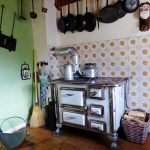This week, I’m discussing the subject of VAT on “builders’ materials”. If you’re a property developer or you’re planning to make a DIY (i.e. self-build) home-builder or home-converter claim, you can only claim VAT on certain goods, which are defined as “builders’ materials”.
So what exactly ARE builders’ materials? Well of course, it’s a lot more than bricks and mortar. But it’s not as simple as you’d think.
The principle isn’t so much that you can’t claim VAT on “luxury” expenditure, but that you can only claim VAT on expenditure that’s necessary for the property to function.
you can’t claim VAT on “luxury” expenditure, but that you can only claim VAT on expenditure that’s necessary for the property to function.
In fact, the VAT legislation clearly defines the goods that are NOT builders’ materials and it’s quite comprehensive:
a) finished or prefabricated furniture, other than furniture designed to be fitted in kitchens;
(b) materials for the construction of fitted furniture, other than kitchen furniture;
(c) electrical or gas appliances, unless the appliance is an appliance which is—
(i) designed to heat space or water (or both) or to provide ventilation, air cooling, air purification, or dust extraction; or
(ii) intended for use in a building designed as a number of dwellings and is a door-entry system, a waste disposal unit or a machine for compacting waste; or
(iii) a burglar alarm, a fire alarm, or fire safety equipment or designed solely for the purpose of enabling aid to be summoned in an emergency; or
(iv) a lift or hoist;
(d) carpets or carpeting material.
Extract from VAT Act 1994, Schedule 8, Group 5, Note 22.
The rules are set out in detail for developers in VAT Notice 708, section 13 http://tinyurl.com/n6gttof and section 3 of the VAT claim forms 431B and 431C for DIY housebuilders and converters http://tinyurl.com/pt9ec7h. The lists are almost exactly the same, apart from some minor clarifications. But the principles are the same. They include lists of goods on which you can claim VAT and lists of goods on which you can’t claim VAT.
 Most people understand the basic principles; i.e. that you can’t claim VAT on most electric or gas appliances, furniture and carpets. Another important principle is that you can only claim VAT if the goods are both “incorporated” into the property. They must also be of a type “ordinarily incorporated” into that type of property by builders. For example, you wouldn’t normally install church pews into a dwelling, so you can’t claim VAT on pews installed into a dwelling. That’s a bit of an extreme example, but there is some helpful in VAT Notice 708 about goods that would be “ordinarily installed” in a range of properties that will be used for “relevant residential” and “relevant charitable” purposes.
Most people understand the basic principles; i.e. that you can’t claim VAT on most electric or gas appliances, furniture and carpets. Another important principle is that you can only claim VAT if the goods are both “incorporated” into the property. They must also be of a type “ordinarily incorporated” into that type of property by builders. For example, you wouldn’t normally install church pews into a dwelling, so you can’t claim VAT on pews installed into a dwelling. That’s a bit of an extreme example, but there is some helpful in VAT Notice 708 about goods that would be “ordinarily installed” in a range of properties that will be used for “relevant residential” and “relevant charitable” purposes.
So why does it cause so many problems?
One of the main problems is dealing with expenditure that’s not included on any of the lists in Notice 708. I was once asked by a developer “why don’t they just issue a complete list of goods where you can claim VAT?” Therein lies the problem: no list is ever exhaustive. And like it or not, VAT is a self-assessed tax and the claimant has to make their own decision when they complete their VAT return or DIY claim.
But there are a few specific aspects that may help.
How do you define “items ordinarily installed”?
First of all, what about those items that aren’t included on HMRC’s lists, either the “yes” list or the “no” list? Well it’s all about practicality really – we all have different ideas about the normal contents of a home and it’s almost impossible to identify and cover every single item. If you read decisions from the VAT and First Tier Tax Tribunals about VAT on “builders’ materials”, you’ll see many dealing with goods that aren’t on either lists.
A good example of how the rules apply is free range cookers, such as agas. Under the main principles, you can only claim VAT on such cookers if they are solid fuel, oil-fired or designed to heat space or water. If the cooker is only used to prepare food, then you can’t claim the VAT.
If you can’t claim VAT on a free range cooker, what about a snooker table? In one case, the Tribunal agreed with HMRC that a snooker table wasn’t an item “ordinarily installed”. Who could ever think it reasonable that a piece of sports equipment was a normal part of basic home equipment?
I’m sure that many people will disagree with my view, but the “snooker table” case shows that the whole issue is very subjective. I think that for the most part, it’s a matter of using some common sense.
Interpretation of the rules: so what is a vanity unit?
Next, how do you interpret what’s on either of the lists? A good example is vanity units and whether they’re regarded as “furniture”. As a permanent fixture, you’d think that VAT could be claimed. But HMRC say that you can’t claim VAT on “elaborate vanity units”. What do they mean by this? How do you define the word “elaborate”?
Again, I think it’s a matter of functionality. If it’s simply to hold the wash basin in place and cover the pipework, then it’s not regarded as “furniture”. This is what HMRC says:
“Deeper units where the use of the cupboards has a true function such as base units incorporating a wash hand basin installed in bathrooms, cloakrooms and bedrooms, are also not furniture, provided that the only cupboard space is directly beneath the basin itself.
More elaborate vanity units, typically with other storage space constructed on either or both sides of the basin, are furniture, as are wall units such as bathroom cabinets.”
Technology
Finally, one of other important aspect is how technology has developed since the legislation was introduced. A good example are combined entry and security systems. You can claim VAT on burglar alarms, but you can’t claim VAT on CCTV cameras. CCTV cameras weren’t in general use when the legislation was written.
If you’re going even more upmarket, with electric gates and keypads, security systems that rely on finger prints, voice recognition or retinal scanning, then these are “electrical appliances”. HMRC will normally allow you to claim VAT on basic electronic gates or doors. If your system is more sophisticated, then you can can only claim the VAT that relates to the basic system. Again this issue can be subjective, but it goes back to the principle that anything beyond a gate or a door isn’t essential to the functioning of a dwelling.
Conversions: more restricted
The subject of VAT on “builders’ materials” for DIY/self-build conversions has its own set of rules. In principle, you can’t claim VAT on all of the “builders’ materials” mentioned above.
There are two main differences:
- Conversion services are liable to the reduced rate of 5%
- You can’t claim VAT on as much expenditure.
What does all of this mean? Well, unlike DIY house builders or commercial developers building new properties, you can claim VAT on both goods and the services of installing the goods. However, you can only claim VAT on works to the fabric of the building itself and within the immediate site of the building. Where the work is outside the building itself, you can only claim VAT for works that are in connection with specific services, such as the provision of utilities.
Because the 5% rate applies to conversions, you can claim 5% on services and related goods, as well as 20% VAT on goods that you have purchased directly and installed yourself. One very important point is that you can only claim VAT that has been “correctly charged”. If your contractor has charged 20% for work that qualified for the reduced rate, you can’t claim the VAT on your VAT return or DIY claim. You have to go back to the contractor and ask them to refund overcharged VAT.
Making the claim
Commercial developers
Whether you’re a commercial developer or a DIY/self-build claimant, you have to be careful that you don’t knowingly claim VAT on expenditure that isn’t allowed. Remember that by signing and submitting the claim you’re making a legal declaration. If you’re a commercial developer, you should only claim VAT if you’re certain that the expenditure qualifies. Otherwise, I’d recommend that you write to HMRC for a formal ruling on the issue or take professional advice. There are penalties for submitting error returns, so it’s always better to err on the side of caution.
DIY claimants
If you’re uncertain about whether you can claim VAT on any specific expenditure for self-build projects, I’d suggest calling HMRC’s DIY office before you submit the claim to ask for their advice. HMRC normally review the invoices for any claim and will disallow claims if the expenditure concerned doesn’t fall within the rules. They rarely reject claims in their entirety, but will usually simply reduce the value of the claim.
if you think that there is a case to claim VAT then I’d suggest including some of the VAT on your claim, explaining that you have only claimed VAT on that proportion of the invoice that you believe qualifies. For example, if the invoice if for the door and gates including sophisticated electronic gates or voice recognition systems, HMRC will almost certainly allow you to claim some of the VAT. Just be open about the situation and that will help you to get the best result.
Of course if you don’t agree with their decision, you can appeal to the Tax Tribunal, but this is a time consuming and potentially expensive process. Unfortunately even if HMRC’s decision is wrong and the Tribunal rules in your favour, you still have to bear the cost and that could cost more than the amount of VAT involved.
Any questions?
Over the next few months, I’ll be discussing some of the most common subjects about VAT on “builders’ materials”. Please send any specific queries about the subject of VAT on “builders’ materials” and I’ll include them here on the website.
Marie
July, 2016
